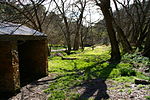1980 Ash Wednesday bushfires
1980 fires1980 in Australia1980s in South Australia1980s wildfiresArson in Australia ... and 2 more
Bushfires in South AustraliaUse Australian English from January 2016
The first Ash Wednesday fires were a series of bushfires that began in the Adelaide Hills, South Australia, on Ash Wednesday, 20 February 1980. 51 homes and 25 other buildings were destroyed, including the Anglican Christ Church, Longwood, and 75 farms were affected. 40 people were injured, with 150 left homeless. The fire burnt an area of 3,770 ha (14.6 sq mi), and caused an estimated $34,000,000 damage.In 1983, after the Ash Wednesday fires in February that year, the 1980 fire became known in South Australia as the "first" Ash Wednesday, or Ash Wednesday I.
Excerpt from the Wikipedia article 1980 Ash Wednesday bushfires (License: CC BY-SA 3.0, Authors).1980 Ash Wednesday bushfires
Teringie Drive, Adelaide Hills Council
Geographical coordinates (GPS) Address Nearby Places Show on map
Geographical coordinates (GPS)
| Latitude | Longitude |
|---|---|
| N -34.911194 ° | E 138.707361 ° |
Address
Teringie Drive
Teringie Drive
5136 Adelaide Hills Council, Teringie
South Australia, Australia
Open on Google Maps





